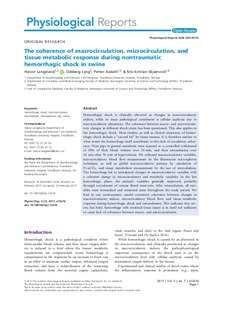| dc.contributor.author | Langeland, Halvor J.B. | |
| dc.contributor.author | Oddveig, Lyng | |
| dc.contributor.author | Petter, Aadahl | |
| dc.contributor.author | Skjaervold, Nils Kristian | |
| dc.date.accessioned | 2017-07-06T07:29:19Z | |
| dc.date.available | 2017-07-06T07:29:19Z | |
| dc.date.created | 2017-07-05T11:33:10Z | |
| dc.date.issued | 2017 | |
| dc.identifier.issn | 2051-817X | |
| dc.identifier.uri | http://hdl.handle.net/11250/2448003 | |
| dc.description.abstract | Hemorrhagic shock is clinically observed as changes in macrocirculatory indices, while its main pathological constituent is cellular asphyxia due to microcirculatory alterations. The coherence between macro‐ and microcirculatory changes in different shock states has been questioned. This also applies to the hemorrhagic shock. Most studies, as well as clinical situations, of hemorrhagic shock include a “second hit” by tissue trauma. It is therefore unclear to what extent the hemorrhage itself contributes to this lack of circulatory coherence. Nine pigs in general anesthesia were exposed to a controlled withdrawal of 50% of their blood volume over 30 min, and then retransfusion over 20 min after 70 min of hypovolemia. We collected macrocirculatory variables, microcirculatory blood flow measurement by the fluorescent microspheres technique, as well as global microcirculatory patency by calculation of Pv‐aCO2, and tissue metabolism measurement by the use of microdialysis. The hemorrhage led to anticipated changes in macrocirculatory variables with a coherent change in microcirculatory and metabolic variables. In the late hemorrhagic phase, the animals' variables generally improved, probably through recruitment of venous blood reservoirs. After retransfusion, all variables were normalized and remained same throughout the study period. We find in our nontraumatic model consistent coherence between changes in macrocirculatory indices, microcirculatory blood flow, and tissue metabolic response during hemorrhagic shock and retransfusion. This indicates that severe, but brief, hemorrhage with minimal tissue injury is in itself not sufficient to cause lack of coherence between macro‐ and microcirculation. | nb_NO |
| dc.language.iso | eng | nb_NO |
| dc.publisher | Wiley Open Access | nb_NO |
| dc.rights | Navngivelse 4.0 Internasjonal | * |
| dc.rights.uri | http://creativecommons.org/licenses/by/4.0/deed.no | * |
| dc.title | The coherence of macrocirculation, microcirculation, and tissue metabolic response during nontraumatic hemorrhagic shock in swine | nb_NO |
| dc.type | Journal article | nb_NO |
| dc.type | Peer reviewed | nb_NO |
| dc.description.version | publishedVersion | nb_NO |
| dc.source.volume | 5(7) | nb_NO |
| dc.source.journal | Physiological Reports | nb_NO |
| dc.identifier.doi | 10.14814/phy2.13216 | |
| dc.identifier.cristin | 1480927 | |
| dc.description.localcode | ª2017 The Authors.Physiological Reportspublished by Wiley Periodicals, Inc. on behalf ofThe Physiological Society and the American Physiological Society.This is an open access article under the terms of the Creative Commons Attribution License,which permits use, distribution and reproduction in any medium, provided the original work is properly cited. | nb_NO |
| cristin.unitcode | 194,65,25,0 | |
| cristin.unitname | Institutt for sirkulasjon og bildediagnostikk | |
| cristin.ispublished | true | |
| cristin.fulltext | original | |
| cristin.qualitycode | 1 | |

